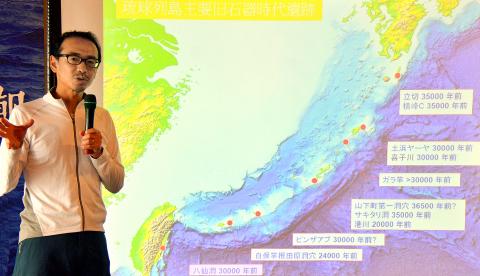In an effort to solve the riddle of whether humans made the long journey from Taiwan to Okinawa in Japan more than 30,000 years ago, Japan’s National Museum of Nature and Science announced on May 24 a joint study with Taiwan’s National Museum of Prehistory to make a test journey in mid June in the seas approximately 30 km off the coast of Taiwan in a bamboo raft.
Human bones dating to the Palaeolithic discovered in Okinawa have DNA characteristic of people from Southeast Asia. It is therefore thought that these people possibly originated from the south. Some archaeologists believe that prehistoric humans made the trip across the sea to Okinawa from Taiwan, which was joined at the time to the Asian mainland.
Last July the research team made a test journey between Okinawa’s Yonaguni and Iriomote-jima islands, traveling roughly 70 km in a thatched boat. The trip was originally set for 2019, to travel between Yonaguni Island and Taiwan — a journey of 110km at the shortest point — but it was decided to first make a short trial journey to carry out tests, including for the influence of the Kuroshio Current en route.

Photo: CNA
照片:中央社
Since Taiwan cannot grow reeds suitable for making thatched rafts, next month’s trial journey will be carried out in a raft, approximately 10 meters long, 80 cms wide and able to hold five people, made of bamboo grown in Taiwan. The plan is to set off in the bamboo raft from Taiwan’s southeast coast to a point 30 kms offshore, which is expected to take at least 10 hours.
In addition to testing the influence of the Kuroshio Current, this trial bamboo raft journey is also designed to test the raft’s durability and stability, as well as capacity, in terms of how many people and how much food it can hold.
According to Yousuke Kaifu, who is leading the research team, “We want to see what the buoyancy and speed of the bamboo raft is like. People 30,000 years ago would not have had many tools, and we would really like to find out from this trial journey how exactly they would have been able to cross the Kuroshio.”
The research team will use the data obtained from June’s test journey to decide the route and details of the plan for the 2019 journey.
(CNA, translated by Paul Cooper)
為解開逾三萬年前人類是否從台灣遠渡沖繩之謎,日本國立科學博物館五月二十四日宣布將與國立台灣史前文化博物館合作,六月中旬在台灣外海約三十公里試航竹筏。
在沖繩所發現到的舊石器時代人骨有目前在東南亞人骨DNA的特徵,因此被認為可能是來自南方。有考古學家研判,可能這些史前人類是從當時與亞洲大陸連結的台灣藉由航海遠渡沖繩。
研究團隊去年七月在沖繩的與那國島至西表島之間,以草船試航約七十公里。原本預定二○一九年實施與那國島與台灣之間(最短距離是一百一十公里)的試航,但為了調查航路途中黑潮的影響等,決定先實施短程試航。
因為台灣並沒生長適合造船的草,所以下個月試航是以生長在台灣的竹子所打造長約十公尺、寬約八十公分、可載五人的竹筏進行實驗。計畫從台灣東南方沿岸划竹筏到距離三十公里遠的離島,預估至少要十個小時。
這次的竹筏試航,除了要調查黑潮的影響之外,也調查竹筏的耐久性、安定性、可搭載多少人與食物等。
研究團隊的負責人海部陽介表示,「想調查竹筏能有多少浮力、速度如何。三萬年前的人應該沒有充足的道具,究竟是如何跨越黑潮的 ,很想藉由試航,一探究竟。」
研究團隊將以六月試航所得資料為根據,再決定二○一九年試航路線、計畫細節等。
(中央社)
FOLLOW UP
讀後問題
1) Why is it thought that people actually made the journey over from Taiwan 30,000 years ago?
2) Is it possible to infer from this article that the people who originally made the trip came from the Asian mainland?
3) Why make this trial trip in a bamboo raft, instead of a thatched boat?
4) What do the research team hope to learn from this trip?

For many people in Taiwan, childhood memories of rural life include pig pens standing beside family homes. Leftover rice, vegetable scraps and soup from daily meals were poured into buckets and fed to pigs. This practice of feeding pigs with household food waste was once a common way of life, both an economic choice and an expression of agricultural society’s deep respect for conserving resources. From a practical standpoint, pigs are omnivorous animals capable of efficiently digesting food scraps that humans can no longer eat. For rural households, food waste cost almost nothing, yet it could be converted into pork, a

Tango unfolds in a dimly lit room, where a haunting melody ushers two dancers into a close embrace. Here, music and movement merge into a silent yet passionate conversation, expressing longing, memory and shared purpose. What makes tango truly magical is the deep interaction and spontaneous improvisation between partners. Tango began in the late 19th century in Buenos Aires, Argentina’s bustling capital. Born in the poor working-class neighborhoods and busy port areas, this dance emerged from a melting pot of cultures. European immigrants, African slaves and local residents all contributed to its unique character. From these rich influences, tango

A: What show are you watching online? B: I’m watching “Fly Me to the Moon & Back” – an exhibition launched by the Taipei Music Center (TMC) to commemorate the late singer Tom Chang. A: Known for his sky-high notes, Chang is praised as one of the best singers in the 1990s. His death at the age of 31 was a major loss indeed. B: And I’m so glad that we went to the TMC’s 90s-themed concert last Friday. I finally saw the iconic “Godmother of Rock” WaWa perform live. A: This year-end show also featured singers Princess Ai, Bii, Wayne Huang, PoLin and

A: Apart from the Taipei Music Center’s exhibit and concert, US pop rock band OneRepublic and rapper Doja Cat are touring Kaohsiung this weekend. B: OneRepublic is so popular that after tonight’s show at the K-Arena, they are set to return to Taiwan again in March next year. A: And Doja will also perform at the same venue on Sunday, right? B: Yup. Her collab with Blackpink’s Lisa and singer Raye for the song “Born Again” has been a huge worldwide success. A: Doja even made it on Time magazine’s “100 Most Influential People” list in 2023. She’s so cool. A: 本週末除了北流的特展和演唱會外,美國男團共和世代和饒舌歌手蜜桃貓朵佳也將來台開唱。 B: 共和世代因太受歡迎,繼今晚高雄巨蛋的演唱會後,預計明年3月即將再度來台巡演唷。 A: 朵佳本週日將在同場地開唱,對不對?